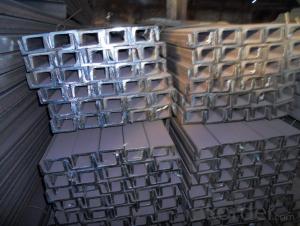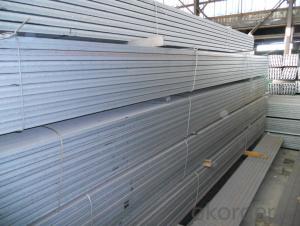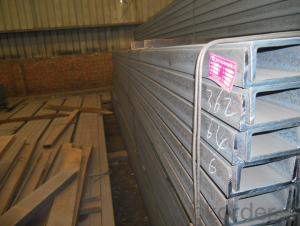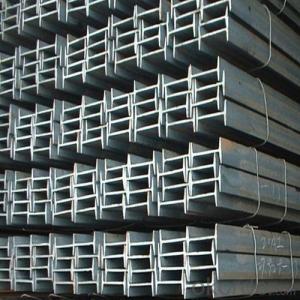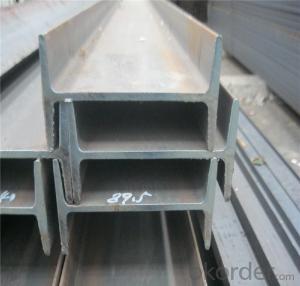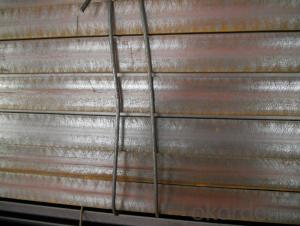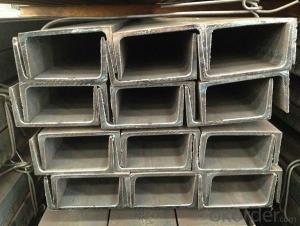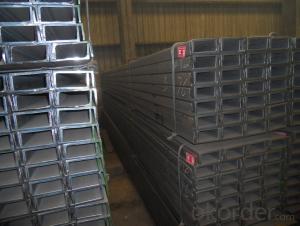High Quality Hot Rolled U-Channel Steel
- Loading Port:
- Tianjin
- Payment Terms:
- TT or LC
- Min Order Qty:
- 20 m.t.
- Supply Capability:
- 1000 m.t./month
OKorder Service Pledge
OKorder Financial Service
You Might Also Like
Product Description:
OKorder is offering Hot Rolled Steel U-Channel at great prices with worldwide shipping. Our supplier is a world-class manufacturer of steel, with our products utilized the world over. OKorder annually supplies products to European, North American and Asian markets. We provide quotations within 24 hours of receiving an inquiry and guarantee competitive prices.
Product Applications:
Hot Rolled Steel U-Channel can be applied to construction of warehouses, workshops, sport stadiums and car parks etc.The hot rolled channel steel belongs to carbon structural steel which is applied to in the field of construction and machinery.In details, the hot rolled channel steel is usually used for arch-itechtural structure, and they could be welded in order to support or hang a vari-ety of facilities. They are also usually used in combination with I beam. Generally,the hot rolled channel steel we supply must possess perfect welding property, riveting property and mechanical property and so on.
Product Advantages:
OKorder's Hot Rolled Steel U-Channel are durable, strong, and resist corrosion.
Main Product Features:
· Premium quality
· Prompt delivery & seaworthy packing (30 days after receiving deposit)
· Corrosion resistance
· Can be recycled and reused
· Mill test certification
· Professional Service
· Competitive pricing
Product Specifications:
We supply high quality MS Channel at reasonable price, including Chinese standard, Japanese standard and so on.
Standard | GB/JIS |
Material Grade | Q235,SS400 |
Technique: | Hot Rolled |
Sizes as per chinese standard: | 50*37*4.5mm - 300*89*11.5mm |
Sizes as per japanese standard: | 50*25*3mm – 200*80*7.5mm |
Length: | 6meter, 9meter, 12meter |
The chemical composition of HR Channel Steel according to Q235B
Alloy No | Grade | Element(%) | ||||
C | Mn | S | P | Si | ||
Q235 | B | 0.12-0.20 | 0.3-0.7 | ≦0.045 | ≦0.045 | ≦0.3 |
Alloy No | Grade | Yielding Strength Point(Mpa) | |||
Thickness(mm) | |||||
≦16 | >16-40 | >40-60 | >60-100 | ||
≧ | |||||
Q235 | B | 235 | 225 | 215 | 205 |
Package & Delivery of MS Channel:
1.The hot rolled channel steel will be packed in bundle with steel wire at each end of every bundle and color marking in order to help the customer to recognize his goods more easily at sight.
2. And the hot rolled channel steel could be loaded into 20ft or 40ft container, or by bulk cargo.If the weight of each bundle reaches more than 3.5 mt, the loading by break bulk cargo should be choosed.When the weight of each bundle reaches less than 3mt, the loading by container should be choosed.
3.As for the transportaion from mill to loading port, the truck will be usually used. And the maximum quantity for each truck is 40mt.
4.All in all, we could do in accordance with customer's request
FAQ:
Q1: Why buy Materials & Equipment from OKorder.com?
A1: All products offered byOKorder.com are carefully selected from China's most reliable manufacturing enterprises. Through its ISO certifications, OKorder.com adheres to the highest standards and a commitment to supply chain safety and customer satisfaction.
Q2: How do we guarantee the quality of our products?
A2: We have established an advanced quality management system which conducts strict quality tests at every step, from raw materials to the final product. At the same time, we provide extensive follow-up service assurances as required.
Q3: How soon can we receive the product after purchase?
A3: Within three days of placing an order, we will begin production. The specific shipping date is dependent upon international and government factors, but is typically 7 to 10 workdays.
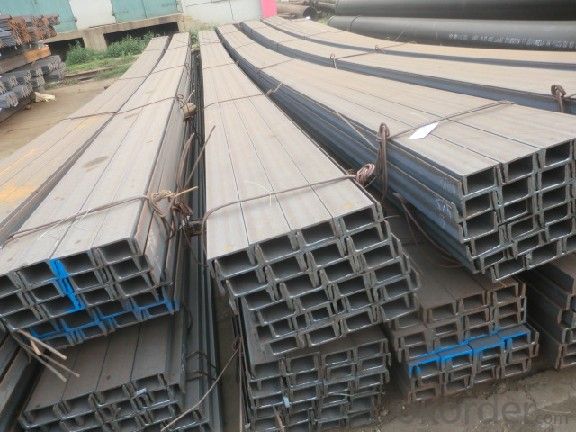
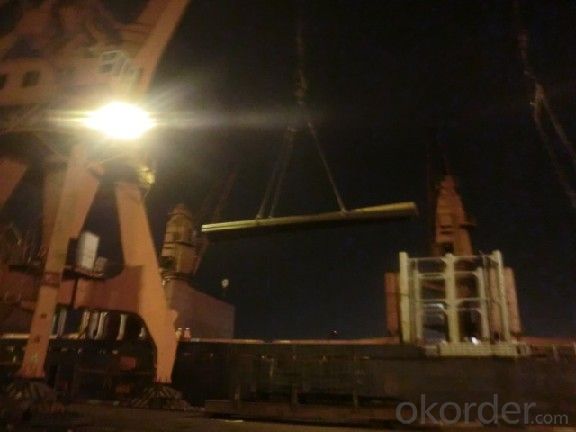
- Q: What are the different types of loads that steel I-beams can withstand?
- Steel I-beams are designed to withstand various types of loads, including dead loads, live loads, and lateral loads. Dead loads refer to the weight of the structure itself and any permanent fixtures, such as walls or equipment. Live loads are temporary loads caused by people, furniture, or other movable objects. Lateral loads, also known as wind or seismic loads, refer to forces that act horizontally on the structure. Steel I-beams are engineered to handle these different types of loads to ensure the structural integrity and safety of the building or structure.
- Q: Can steel I-beams be used for mining applications?
- Indeed, mining applications can make use of steel I-beams. Given their robustness and durability, steel I-beams find frequent application within the mining industry. Their utility spans supporting tunnels, underground structures, and mine shafts. The resilient construction of steel I-beams equips them to endure the immense loads and challenging environments often encountered in mining operations. Furthermore, the adaptability and ease of fabrication of steel I-beams enable them to be tailored to meet precise mining specifications, thus rendering them a favored selection within the industry.
- Q: How do steel I-beams handle vibrations?
- The inherent structural properties of steel I-beams make them highly effective in managing vibrations. The flanges and web of an I-beam contribute to its stiffness and rigidity, allowing it to distribute loads, resist bending, twisting, and deformations caused by vibrations efficiently. The vertical support provided by the web and the horizontal beams formed by the flanges work together to resist bending and enhance the strength of the I-beam. This well-designed structure enables the I-beam to transfer loads and vibrations effectively along its entire length, minimizing the risk of structural failure or damage. Steel itself possesses remarkable strength and durability, which aids in absorbing and dissipating vibrations. Unlike other materials, steel is less prone to resonance, meaning it does not readily vibrate at its natural frequency. This characteristic prevents the amplification of vibrations and reduces the possibility of fatigue failure. Furthermore, the weight and mass of steel I-beams play a significant role in their ability to handle vibrations. The substantial weight of the beams helps dampen and absorb vibrations, preventing their propagation throughout the structure. This quality makes steel I-beams particularly suitable for applications in which vibrations are a concern, such as in bridges, high-rise buildings, and industrial structures. In conclusion, steel I-beams are meticulously designed and engineered to effectively manage vibrations. Their shape, material properties, and weight make them a dependable choice for structural applications where vibration control and stability are of utmost importance.
- Q: Can steel I-beams be used in outdoor or exposed environments?
- Yes, steel I-beams can be used in outdoor or exposed environments. Steel is known for its durability and weather resistance, making it a suitable material for outdoor applications. However, to ensure the longevity of steel I-beams in such environments, they should be properly protected against corrosion. This can be achieved through various methods, such as applying protective coatings like galvanization or painting, or using stainless steel beams that are inherently resistant to corrosion. Regular maintenance and inspections are also essential to identify and address any signs of corrosion or damage. Overall, with proper protection and maintenance, steel I-beams can withstand outdoor or exposed environments effectively.
- Q: What are the factors to consider when designing steel I-beams for heavy machinery support?
- To ensure the structural integrity and safety of the support system for heavy machinery, several factors must be considered when designing steel I-beams. These factors are as follows: 1. Load requirements: The foremost consideration is to determine the maximum load that the I-beams need to support, including both static and dynamic loads exerted by the heavy machinery. Engineers must calculate the weight and distribution of the loads to determine the appropriate size and strength of the I-beams. 2. Material selection: It is crucial to select the right type of steel for the I-beams. The chosen material should possess high strength and resistance to deformation under heavy loads. Commonly used steel grades for heavy machinery support include ASTM A36, ASTM A572, and ASTM A992. 3. Beam size and shape: Careful consideration should be given to the dimensions of the I-beams to ensure they can adequately support the loads. This involves determining the height, width, and thickness of the flanges and web of the beams. The shape of the I-beams should be optimized to provide the best strength-to-weight ratio. 4. Beam spacing and support structure: The spacing between the I-beams must be determined to evenly distribute the load and prevent excessive deflection. The support structure, such as columns or walls, should be designed to provide sufficient stability and stiffness to securely hold the I-beams in place. 5. Welding or bolted connections: The method of connecting the I-beams must be carefully chosen. Welded connections are commonly used for heavy machinery support due to their strength and durability. However, bolted connections offer flexibility for future modifications or repairs. 6. Safety and code compliance: The design must adhere to relevant safety standards and building codes, considering factors such as seismic design requirements, fire resistance, and load capacity factors. 7. Cost considerations: Finally, the cost of materials, fabrication, and installation should be taken into account. Engineers must strike a balance between meeting the load requirements and minimizing costs without compromising safety. By carefully considering these factors, engineers can design steel I-beams that offer robust and reliable support for heavy machinery, ensuring safety and optimal performance in industrial settings.
- Q: How many tons can the No. 30 I-beam load?
- I-beam is mainly divided into ordinary I-beam, light I-beam and H steel three. Ordinary I-beam, light I-beam flange is variable cross-section, depending on the thickness of the web, the external thin; H steel: HW, HM, HN, HEA, HEB, HEM and so on, the flange of I-beam is a uniform section.
- Q: Can steel I-beams be used in marine environments?
- Yes, steel I-beams can be used in marine environments. However, it is important to use corrosion-resistant materials like stainless steel or galvanized steel to prevent rust and degradation due to exposure to saltwater and other harsh elements. Regular maintenance and proper coatings are necessary to prolong their lifespan in marine environments.
- Q: How much is 40 I-beam per ton?
- No. 40 I-beam is the model of ordinary I-beam, divided into a, B, C three kinds, length of a ton are as follows: specification height (mm), leg width (mm), waist thickness (mm), weight (kg/m) per ton length (m)40#a 40014210.5, 67.598, 14.79340#b 40014412.5, 73.878, 13.53640#c 40014614.5, 80.158, 12.475
- Q: How do steel I-beams perform in terms of noise insulation?
- Steel I-beams typically do not provide significant noise insulation due to their rigid and dense nature. They are more commonly utilized for their load-bearing capabilities and structural strength rather than their ability to reduce noise transmission. To effectively reduce noise, additional insulation materials or alternative construction techniques should be considered.
- Q: Can steel I-beams be used in retail or commercial building renovation projects?
- Yes, steel I-beams can definitely be used in retail or commercial building renovation projects. Steel I-beams are commonly used in construction due to their strength and durability. They offer excellent load-bearing capacity, making them ideal for supporting heavy loads in both new construction and renovation projects. In retail or commercial building renovation projects, steel I-beams can be used to reinforce or replace existing structural elements, provide additional support for new additions or expansions, or create open and flexible floor plans by eliminating the need for interior load-bearing walls. Additionally, steel I-beams can be customized to meet specific project requirements, such as length, size, and shape, making them a versatile choice for various renovation applications. Overall, the use of steel I-beams in retail or commercial building renovation projects can enhance structural integrity, increase design possibilities, and ensure the long-term stability and safety of the renovated space.
Send your message to us
High Quality Hot Rolled U-Channel Steel
- Loading Port:
- Tianjin
- Payment Terms:
- TT or LC
- Min Order Qty:
- 20 m.t.
- Supply Capability:
- 1000 m.t./month
OKorder Service Pledge
OKorder Financial Service
Similar products
Hot products
Hot Searches
Related keywords
